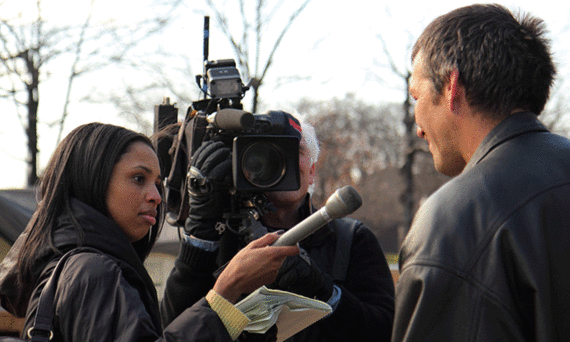Corporate television's obsession with Donald Trump contributed to his rise. But media can be part of the solution instead of the problem. Here's how.
A television news crew interviews an Occupy DC protester at their encampment. Photo by Mr.TinDC / Flickr.
It was early on the last day of the People's Summit, and I was sitting down to breakfast in the giant ballroom. A reporter from a prominent newspaper sat down at the table and began sharing his experiences covering the Bernie Sanders campaign. He had watched as television journalists captured powerful stories from the massive Sanders rallies, only to have their stations cut their stories. It happened again and again.
Earlier, I'd listened while my fellow speaker on the summit's media panel, Jeff Cohen of FAIR, pointed out that all the major presidential candidates got New York Times front-page coverage when they entered the race, but Sanders' announcement was covered on page A21. And when two populist candidates were rising in 2015, one from the left and one from the right, ABC World News Tonight gave Donald Trump 81 minutes of coverage and Sanders 20 seconds.
Commentators seem unable to grasp the lived reality of people who struggle with debt, job insecurity, unaffordable housing, and the cost of medical care
This sort of bias distorts our view of reality and contributes to cynicism and nihilism. Police killings of black people were not covered until Black Lives Matter protests broke out. Until the Occupy movement, inequality was rarely discussed in the media, or it was often framed as good for the economy if it was.
Today, commentators seem unable to grasp the lived reality of people who struggle with debt, job insecurity, unaffordable housing, and the cost of medical care. Seen through the lens of Washington insiders, then, voter rejection of neoliberal candidates in both major parties in favor of populists, Sanders and Trump, would seem puzzling.
What would it mean to cover the news with eyes wide open to the realities of life in the early 21st century, including those leading grassroots change? After 20 years as an editor of YES! Magazine and months of travels around the country, I've come to believe those of us who make editorial decisions have a responsibility to get out of the insider bubble and look unflinchingly at what is happening.
1) We need to get real about what time it is in human history. We are living in a time of human and ecological crisis, and the trends point toward further undermining of our democracy, our commons, and our future. The climate crisis is just one example of a dire story that is underreported. We have a responsibility to cover both the approaching train wreck and those trying to avert it.
2) We need to rethink the "we" in "we the people." Americans are from many races, backgrounds, religions, and life experiences, and more than half are women. Media coverage and commentary should mirror these diverse experiences. Moreover, the accumulated wisdom of many perspectives might just get us through this time of crisis.
3) People who suffer from poverty, racism, sexism, and violence are not only victims; they are shaping the future. The media--even the progressive media--is stuck in a storyline that casts people who are struggling as victims. We do a disservice when we overlook the leadership and creativity coming out of these communities.
4) The political agenda is not only what the powerful say it is. Here's an example: When President Obama was elected, he pressed for health care reform based on private insurance, as is his right as president. But the media covered only the Obama proposal and Tea Party opposition, barely mentioning the nearly two-thirds of Americans who favored single-payer health care. The media should report on popular solutions and how well they work (or don't work), not just on those championed by the powerful.
5) In a time of crisis, the media needs to encourage our radical imagination. By minimizing movements like Black Lives Matter, Occupy, the kayaktivists' protest of a Shell drilling rig, and the Sanders campaign, the media signals that people's movements are unimportant. But that's untrue. A $15 minimum wage, police reform, a halt to Arctic drilling, taxes on the very wealthy--these and other issues are on the table because social movements do make a difference.
Giving demagogues like Trump saturation coverage might boost ratings. Dismissing policies like single-payer health care might appease corporate media owners and advertisers. But media has a higher calling: to cover the reality of people from all walks of life and to show what they are doing to create the sort of world they want.
Sarah van Gelder wrote this article for YES! Magazine where she is co-founder and editor at large. Sarah's upcoming book, The Revolution Where You Live, will be available via YES! Magazine this fall. Follow her on Twitter @sarahvangelder.
